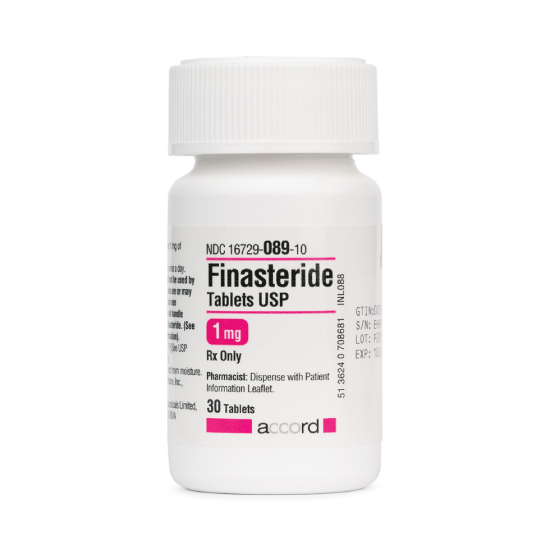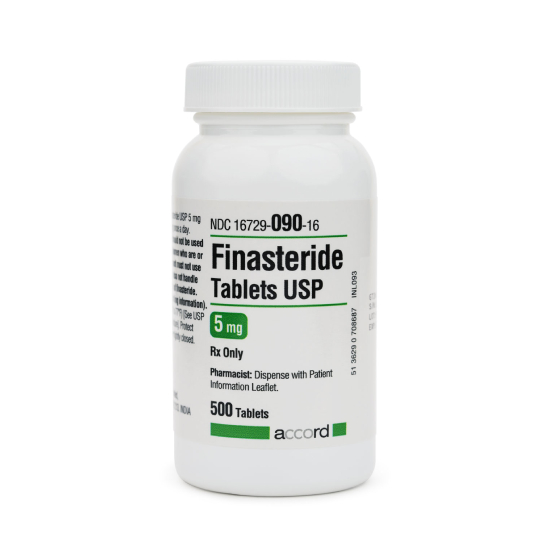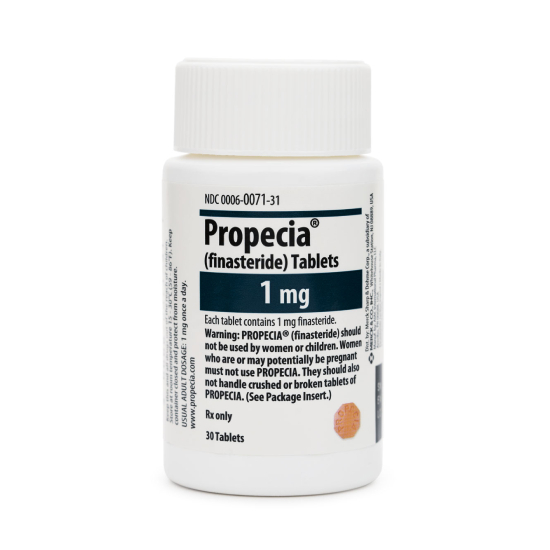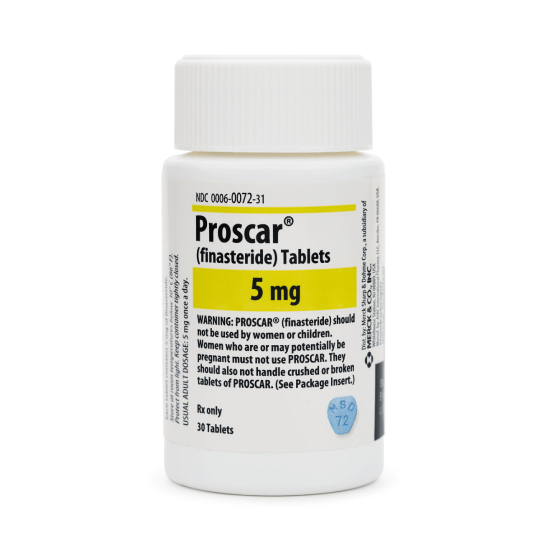This product is available solely through our 503A Compounding Pharmacy, ensuring personalized care and precision in every order. Please note that a valid prescription is required for purchase. If you do not have an account, please contact us.
Finasteride Tablet (Each) †
Finasteride Tablet (Each) †
† commercial product
Finasteride is a 5-alpha reductase inhibitor primarily used to treat benign prostatic hyperplasia (BPH), a condition that affects most men over the age of 50. It helps by reducing prostate size and improving urinary flow. Although finasteride has been shown to increase and maintain maximum urine flow rate, fewer than 50% of patients experience symptomatic relief, despite prostate shrinkage.
In patients treated for 6 months or more, serum PSA (prostate-specific antigen) levels typically decrease by about 50%. However, individual responses may vary. It’s important to note that PSA levels can drop even in the presence of prostate cancer, which may mask the disease. Therefore, when using PSA levels to detect prostate cancer in men taking finasteride, clinicians should double the measured PSA value to compare it to reference ranges in untreated men. Any rise in PSA from baseline, even within the normal range, may indicate prostate cancer.
When using the percent free PSA (free/total PSA ratio) as a diagnostic marker, no adjustment is necessary, as this ratio is not significantly affected by finasteride.
In June 2011, the FDA issued a safety alert based on findings from two large randomized controlled trials—the Prostate Cancer Prevention Trial (PCPT) and the REDUCE trial (which involved dutasteride). The PCPT showed that finasteride reduced the overall risk of prostate cancer by 26% compared to placebo (p < 0.0001), but this benefit was limited to low-grade cancers (Gleason score ≤ 6). Notably, the incidence of high-grade cancers (Gleason score 8–10) was higher in the finasteride group than in the placebo group (1.8% vs. 1.1%).
Finasteride is also approved for the treatment of male pattern hair loss (androgenetic alopecia), where it has demonstrated effectiveness in men with mild to moderate hair loss at the vertex and anterior mid-scalp. However, it has not been proven effective for bitemporal recession.
Finasteride is a man-made version of testosterone called a 4-aza analog. It works by blocking a specific enzyme, type II 5-alpha reductase, which is inside cells and changes testosterone into a stronger form of male hormone called DHT. The type II enzyme is responsible for about two-thirds of the DHT in the body. When used to treat an enlarged prostate, it stops the body from converting testosterone into DHT, which reduces the size of the prostate and improves urine flow. In male pattern baldness, the bald part of the scalp has smaller hair follicles and higher levels of DHT compared to areas with hair. Finasteride lowers DHT levels in both the scalp and the blood, which helps stop the growth of hair loss in people who are genetically prone to it. So far, it does not seem to affect the levels of other hormones like cortisol, estradiol, prolactin, thyroid-stimulating hormone, thyroxine, or cholesterol. Studies also suggest that finasteride does not impact the hypothalamic-pituitary-testicular axis.
Contraindications:
These are conditions where Finasteride should not be used, as it may cause harm.
Hypersensitivity to Finasteride or any of its components: If a person is allergic to Finasteride, they should avoid it completely.
Pregnancy: Finasteride is contraindicated in women who are pregnant or may become pregnant. This is because it can cause abnormalities in the development of male fetal genitalia. Pregnant women should not handle crushed or broken Finasteride tablets as the drug can be absorbed through the skin.
Liver Dysfunction: Finasteride is metabolized in the liver. It is contraindicated in individuals with severe liver disease as it can worsen liver function.
Children and Adolescents: The drug is not approved for use in children and adolescents under 18 years of age.
Precautions:
These are conditions or situations where the use of Finasteride requires extra caution or monitoring.
Prostate Cancer: Finasteride may lower PSA (prostate-specific antigen) levels, which could affect the ability to detect prostate cancer. It is important to monitor PSA levels regularly and ensure any prostate cancer screening is properly done.
Liver Disease: Caution is advised when using Finasteride in individuals with mild to moderate liver impairment. Regular liver function tests are recommended.
Hypotension (Low Blood Pressure): Finasteride may cause a reduction in blood pressure, so individuals with hypotension or those taking antihypertensive medications should be monitored.
Psychiatric Effects: Some users may experience depression, anxiety, or mood changes while on Finasteride. It’s important to be aware of any mood alterations and seek medical advice if needed.
Sexual Side Effects: Finasteride can cause sexual side effects like decreased libido, erectile dysfunction, and reduced semen volume. These effects may persist after discontinuing the drug in some individuals, so they should be informed beforehand.
Breast Changes: There have been reports of breast tenderness, enlargement, or lumps in some men using Finasteride. In rare cases, it has been associated with an increased risk of breast cancer.
Use with Other Drugs: Finasteride may interact with other medications, especially those affecting the liver’s cytochrome P450 system. Caution should be taken when combining Finasteride with other drugs metabolized by the liver.
Surgical Procedures: If a patient is scheduled for surgery (especially involving anesthesia), the surgeon should be informed that the patient is taking Finasteride.
Saw Palmetto (Serenoa repens):
This mechanism is similar to that of 5-alpha reductase inhibitors like finasteride and dutasteride. While the concurrent use of saw palmetto with these medications is common among patients, the exact effects of combining the two are not well studied. In theory, their effects could be additive, but it is unclear whether this would be beneficial or potentially harmful.
Soy Isoflavones:
Soy isoflavones have been suggested to inhibit type II 5-alpha-reductase. Because of this, there could be an additive effect when used alongside other 5-alpha reductase inhibitors, though the clinical significance of this interaction remains uncertain.
Terazosin:
When used together with finasteride, terazosin has been reported to increase the peak concentration of finasteride by approximately 16% and the area under the curve (AUC) by 31%. However, this interaction is considered to be of minor clinical importance.
Common Side Effects:
Gynecomastia: Breast tenderness/enlargement.
Headache, dizziness, and rash.
Testicular pain.
Serious Side Effects:
Allergic reactions: Swelling or breathing difficulties.
Breast cancer: Lumps, tenderness, or nipple discharge.
Mood changes: Depression, anxiety, or suicidal thoughts.
Prostate cancer: Can affect PSA levels.
Rare Side Effects:
Liver damage: Jaundice, dark urine.
Persistent sexual side effects: Including erectile dysfunction after stopping the drug.
Anaphylaxis: Severe allergic reaction
Finasteride is n’t FDA- approved for use in ladies of travail eventuality and is contraindicated during gestation.The distribution of finasteride into mortal semen has been assessed and appears to be well below the threshold attention associated with fetal anomalies in creatures.
Finasteride is n’t FDA- approved for use in ladies of travail eventuality and is recommended to be avoided during breastfeeding. It is n’t known whether finasteride is excreted in mortal milk. thus, the goods of finasteride on breastfeeding or a nursing child can not be determined.
Store this medication at 68°F to 77°F (20°C to 25°C) and away from heat, moisture and light. Keep all medicine out of the reach of children. Throw away any unused medicine after the beyond-use date. Do not flush unused medications or pour down a sink or drain.
- Proscar (finasteride) package insert. Whitehouse Station, NJ: Merck and Co.; 2014 Jan.
- Thompson IM, Goodman PJ, Tangen CM, et al. The influence of finasteride on the development of prostate cancer. N Engl J Med 2003:349:213-22.
- FDA Drug Safety Communication: 5-alpha reductase inhibitors (5-ARIs) may increase the risk of a more serious form of prostate cancer. Retrieved June 9, 2011.
- Kaplan SA, Holtgrewe HL, Bruskewitz R, et al. Comparison of the efficacy and safety of finasteride in older versus younger men with benign prostatic hyperplasia. Urology 2001;57:1073-7.
- Steiner JF. Clinical Pharmacokinetics and pharmacodynamics of finasteride. Clin Pharmacokinet 1996;30:16-27.
- Propecia (finasteride) package insert. Whitehouse Station, NJ: Merck and Co., INC.; 2013 Sept.
- Lee SJ, Park JB, Kim D,et al. In vitro selective inhibition of human UDP-glucuronosyltransferase (UGT) 1A4 by finasteride, and prediction of in vivo drug-drug interactions. Toxicol Lett. 2015;232:458-465.
- Robbers JE, Tyler VE. Tyler’s Herbs of Choice: the Therapeutic Use of Phytomedicinals. Binghamton, NY: Haworth Herbal Press, Inc.; 1999.
- Marks LS, Hess DL, Dorey FJ, et al. Tissue effects of saw palmetto and finasteride: use of biopsy cores for in situ quantification of prostatic androgens. Urology 2001;57:999-1005.
- Aldercreutz H, Mazur W. Phyto-estrogens and western diseases. Ann Med 1997;29:95-120.
- Samara EE, Hosmane B, Locke C, et al. Assessment of the pharmacokinetic-pharmacodynamic interaction between terazosin and finasteride. J Clin Pharmacol 1996;36:1169-78.
- Vashi V, Chung M, Hilbert J, et al. Pharmacokinetic interaction between finasteride and terazosin, but not finasteride and doxazosin. J Clin Pharmacol 1998;38:1072-1076.
- McConnell JD, Bruskewitz R, Walsh P, et al. The effect of finasteride on the risk of acute urinary retention and the need for surgical treatment among men with benign prostatic hyperplasia. N Engl J Med 1998;338:557-63.








